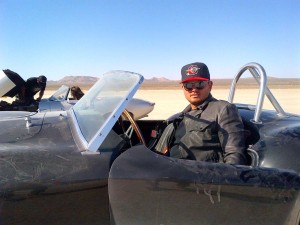
White himself followed in those footsteps, both performing stunts and overseeing them, eventually second unit directing, on everything from a Battlestar Galactica short to a slew of recent action films. He also oversees his own company, T Minus Productions, which does stunt work for features, TV commercials and even live shows.
Live shows? Well, explosions and wire work are everywhere now, and even in an age where you might think digital effects were replacing traditional stunt work, in fact, technology is adding an even edgier edge to the kinds of stunts that get done.
“Wire work,” so beloved of those martial arts epics, and used in fight scenes everywhere, is run through increasingly complex computerized rigs. “We’re flying people in the air, 120 feet in length,” White told us over a recent lunch.
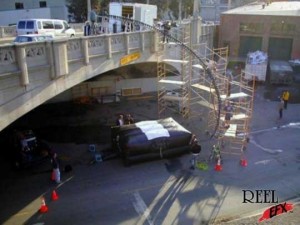 We were there to talk with him about the changing nature of the biz. We’re now in an era where previs for elaborate fight scenes is common, where camera drones are being experimented with to capture chases and vehicle flips, and where cars themselves are so computer-like that someone from Mercedes – to use but one example – has to come “reprogram” cars for stunt work whenever one of their cars is used.
We were there to talk with him about the changing nature of the biz. We’re now in an era where previs for elaborate fight scenes is common, where camera drones are being experimented with to capture chases and vehicle flips, and where cars themselves are so computer-like that someone from Mercedes – to use but one example – has to come “reprogram” cars for stunt work whenever one of their cars is used.
But we weren’t only there to talk about the changes in the stunts themselves. Rather, we were curious about White’s contention that a lot of the same production flight for incentives and tax subsidies that has lured so many shows away from California and studio lots might also be contributing to an atmosphere where more complicated stunts are coming up against tightening budgets and outsourced workers, perhaps forming ingredients for a bad accident that, of course, no one wants, but may be waiting to happen.
He cites as a recent example the death of Sarah Jones on the Georgia set for Midnight Rider (a film from which actor William Hurt announced he is effectively resigning). She was a camera assistant killed by a freight train while the crew was filming on tracks that were not permitted by the rail line that owned them, although there are conflicting reports about whether the land owner of the surrounding acreage had given a permit.
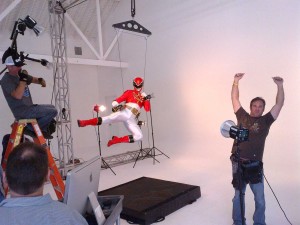 Jones wasn’t doing stunt work, of course, but White chalks the tragedy up to “not taking the added supervision, and not listening to other departments.”
Jones wasn’t doing stunt work, of course, but White chalks the tragedy up to “not taking the added supervision, and not listening to other departments.”
“80% of my job is done in prepping it,” he said. By way of example, he mentions a car chase in Live Free and Die Hard, which he oversaw. There was an animatic of the car chase done in advance, which he showed to the crew at a safety meeting. The 1st A.D. and stunt coordinators were at safe distances when the sequence was filmed. These are all aspects of planning for safety White explained.
A T Minus colleague of his did the same thing in a much tighter space with the close-in-but-spectacular elevator fight in the new Captain America film. That also had a “total previs of the scene” for everything to be worked out in advance.
Especially with the advent of smaller, digital cameras, it’s important to work things out with the director and DP, letting them know “you’ve got to put the camera here.”
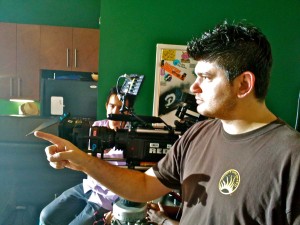 Now though, the pressures to reduce budget and go non-union are becoming more and more evident. “People are being promoted as stunt coordinators who don’t have the resume,” or often were friends of the producer, or held some other job – like line producer – that didn’t involve the actual performing of stunts.
Now though, the pressures to reduce budget and go non-union are becoming more and more evident. “People are being promoted as stunt coordinators who don’t have the resume,” or often were friends of the producer, or held some other job – like line producer – that didn’t involve the actual performing of stunts.
“There’s so much work flowing to other states, they can’t handle it,” said White. Meaning, in this case, adequate safety, planning and skill sets for stunt work. With vehicles alone, “everyone thinks they can drive a car.” He mentions non-union stunt drivers “who can’t hold marks” during takes.
Of course, that union would be SAG, which is the one that stunt performers can join – but “not every stunt guy is union,” said White. Even that wouldn’t guarantee a certain threshold of on-set safety. “Shortcuts are being done in California, too.”
Particularly, he finds that shortcuts are becoming common in the commercial shoots he oversees. “A lot of ad agencies want to do non-union,” White said. Of course, being in SAG himself, he can “only do coordination, but not be photographed.”
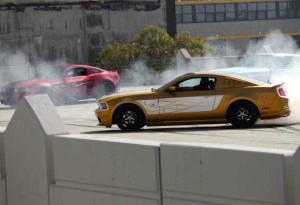 He tries to plan as carefully as he can, making sure everyone holds – and hits – their marks. So far, they have.
He tries to plan as carefully as he can, making sure everyone holds – and hits – their marks. So far, they have.
On the other hand, the skill sets of experienced stunt coordinators are being called upon elsewhere – notably, he said, in Asian productions that value wire work, and particularly in Bollywood. “They like our action design,” White observed. “They like seeing American stunts.”
American audiences do too, of course. But the question remains whether they’ll always see them done safely, or whether that too will become a victim of the downward pressure on wages and costs that affects movie making, just like it does in businesses where people can stay at desks or on assembly lines – and not have to roll cars at all.





